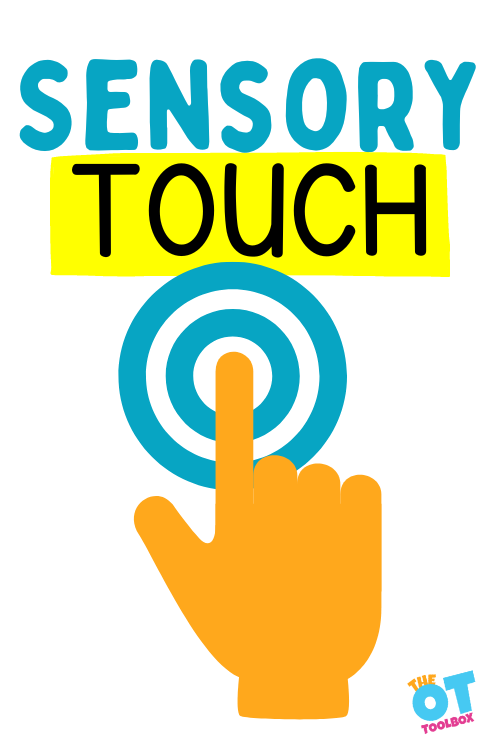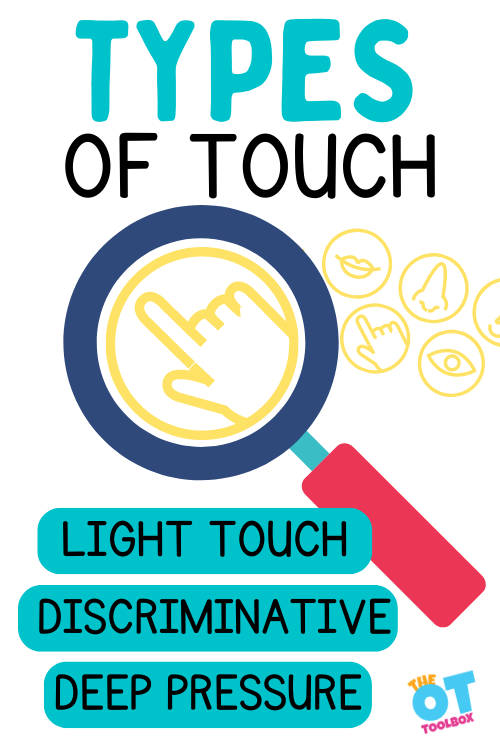One of the first postnatal senses to develop is sensory touch. There are eight senses to sensory processing, with touch being one of the more important ones. The tactile system helps the brain understand and make sense of the world around it. Starting in infancy, people use touch to explore objects, protect themselves from danger, and safely navigate their world. Sensory touch is an important piece to looking at a sensory processing disorder checklist.

Sensory touch
According to what we know about sensory processing, and looking at the sensory processing disorder chart, The body sends tactile information to the somatosensory cortex through neural pathways to the spinal cord, the brain stem, and the thalamus.
The primary somatosensory cortex is the primary receptive area for touch sensations and is located in the lateral postcentral gyrus, a prominent structure in the parietal lobe of the human brain.
Think of sensory touch and the tactile system as a set of wired pathways, similar to the inner workings of a machine. In a typical body, the wires are the correct size, go the right direction, and send the appropriate information from the touch receptors to the brain.

Three Types of sensory touch
There are three types of touch; light touch, deep pressure, and discriminative touch.
- Light touch is alerting. It may alert you to danger such as something touching the skin, or brushing against a spider web. For those with sensory sensitivity, light touch can be bothersome, painful, and elicit negative emotions.
- Deep pressure tends to be calming. Hugs, weighted blankets, and compression clothing, offer external deep pressure sensory touch. Deep pressure can also alert the body about how tight something is, if there is too much pressure, or not enough.
- Discriminative touch alerts the body/brain to the type of sensory touch. It helps describe the incoming information. Was it sticky, wet, dry, rough, bumpy, hot/cold, or smooth?
Sensory Touch Issues
How does this affect people with sensory touch difficulties?
If the sensory touch system is not functioning optimally, the wiring can be off. Some wires might be too large, sending too much information at once (sensitivity).
Other wires may be too small, not sending enough information (sensory seeking).
Sometimes the wires are too long, taking it longer for the messages to be sent to the brain and registered.
Other times the wires don’t go where they are supposed to, and misinformation is sent.
Slow responses to touch sensory input, or the wiring may be too long/send misinformation:
- Doesn’t notice if hands or face are messy or dirty
- Doesn’t cry when seriously hurt and isn’t bothered by minor injuries
- May not notice if bumped or pushed
Seeking out touch sensory input or the wiring is too small:
- Touching people to the point of irritating them
- Loves messy play
- Likes haircuts
- Constantly touching objects, running their hands along the walls, or playing in the dirt
Sensitivity to touch sensory input or the wiring is too big:
- Dislikes having hair cut or brushed
- Difficulty with toe and fingernail cutting
- Fussy with food textures
- Avoids getting messy, wants to wash hands immediately
- Does not explore with touch
- Irritated with certain clothing textures, labels and seams and socks. Avoids new clothes
Sensory Touch and Function
So, how does touch affect functional tasks?
Touch is critical to making sense of the world. Along with the other senses, it teaches the brain the characteristics of an object or situation.
This is the reason babies and young children touch everything! They can not understand a new object without physically exploring it.
Let’s break down the definition of sensory touch terminology:
- Stereognosis – a fancy word meaning; the ability to feel an object, and know what it is without seeing it. An example of stereognosis is reaching into a bag to find a set of keys.
- Dyspraxia – difficulty with motor movements. Without the correct sensory touch information, movements and motor planning can be difficult. Is that sand going to be soft and squishy, how close to the wall am I walking, how much force do I use when petting this puppy?
- Tactile defensiveness – Inability to tolerate touching food, wearing certain clothes, standing in line, being touched, exploring the environment, or experiencing new tactile sensations.
Another component of touch that impacts functional performance is the information about touch that keeps us safe and gives us information about the world around us. This includes touch information such as:
- Where is a particular item touching me?
- The sensory touch awareness that “disappears” over time (feeling your socks on your feet when you put them on, but then not constantly feeling the “feel” of the socks on your feet). This awareness isn’t always present in Autistic individuals.
- Is this item hot or cold?
- Is a particular item too sharp or dangerous?
Somatosensory Touch
Somatosensory touch is a physiological body process which includes several aspects of sensory touch:
- Exteroception input which can include touch sensitivity, thermoreceptive input (heat and temperature awareness), pain receptors
- Interoceptive perception– awareness of pressure or feelings inside the body
- Proprioceptive perception– feelings and awareness of joints and body awareness.
Research about the somatosensory touch sense
There are several research articles available on the somatosensory or tactile system:
- This article covers the sensory neurons of touch, including important information about the somatosensory system which serves three major functions; exteroreceptive (perception of sensory stimuli outside the body and on the skin), interoceptive (perception of internal stimuli inside the body), and proprioceptive functions (for the perception and control of body position and balance). Of important mention is the inclusion of
- This article which covers the development of touch.
- This article which discusses the common influences of the visual and tactile systems in using similar cognitive processes to enable humans to rely merely on one modality in the absence of another to recognize surrounding objects.
- This article discusses how Meissner’s corpuscles work in sensory touch, and how the location and presence of the number and distribution of Meissner’s corpuscles occurs in different locations on the human body.
These are scientific journal articles which provide facts and research on theories about the sensory touch aspect of sensory processing. To the layperson, they are difficult to read and decipher. Using the wiring example above, along with concrete examples may prove to be more beneficial to caregivers.
Sensory Integration and Touch
Sensory integration is the ability to correctly receive and interpret information from the senses. Difficulty with sensory integration, often labeled sensory processing disorder, results in misinformation about incoming information.
It can be in one or more of the senses.
For more information on this theory, please do read our resource on Ayres Sensory Integration for an understanding of what is happening in our nervous systems that results in the motor or behavioral output. It’s truly fascinating!
Why do babies touch everything?
Babies and toddlers explore with touch. A person who has not integrated this sense, may need to explore with touch long beyond the acceptable time frame. Learners who are developmentally delayed may exhibit “inappropriate” sensory behaviors because their system is functioning at a much lower level.
A four year old functioning at a one year old level would be expected to explore with taste and touch.
Infants and children who are born prematurely may also have difficulty with sensory regulation. Their sensory systems were not developed well in utero, and it is almost impossible to mimic the womb sensations in an external NICU.
Premature children may be especially vulnerable to sensory challenges.
Sensory Touch Preferences
Everyone has their own set of sensory preferences. You might dislike wearing jeans, cut the tags in your clothing, love snuggling under a heavy blanket, or prefer not to get messy.
These can be normal reactions to touch. It becomes a problem when the reaction to sensory input impacts function.
The person who can not wear any clothes, is not able to be around people who might touch them, or has a panic attack stepping on the sand, are on the further ends of the typical spectrum.
Their ability to lead a productive life is being compromised by their sensory difficulties. These are the people who may benefit from treatment.
What can I do about this?
The first step is understanding. Understanding a child is not “bad” or being difficult on purpose. Provide good tactile experiences to nurture and build the sensory system.
Amazon affiliate links are in this list below.
- My book, (Amazon affiliate links) Seeing your Home and Community with Sensory Eyes, is a good resource for understanding how each sensory system can affect function and behavior.
- The Out of Sync Child
- The Sensory Lifestyle Handbook as a great start to understanding sensory touch processing along with the other senses.
- Trial sensory brushing as a tool and tactic to support needs
Hands on strategies to support sensory touch:
- The OT Toolbox is full of activities and resources for developing the tactile system.
- Check out the Fall Tactile Sensory Activities from the archives.
- Don’t miss these Backyard Sensory Activities.
Understanding sensory touch, along with the other seven senses is tricky and complicated. What seems like a basic human function, can be a tangled web of crossed wires and misinformation.
NOTE*The term, “learner” is used throughout this post for readability and inclusion. This information is relevant for students, patients, clients, preschoolers, kids/children of all ages and stages or whomever could benefit from these resources. The term “they” is used instead of he/she to be inclusive.

Victoria Wood, OTR/L is a contributor to The OT Toolbox and has been providing Occupational Therapy treatment in pediatrics for more than 25 years. She has practiced in hospital settings (inpatient, outpatient, NICU, PICU), school systems, and outpatient clinics in several states. She has treated hundreds of children with various sensory processing dysfunction in the areas of behavior, gross/fine motor skills, social skills and self-care. Ms. Wood has also been a featured speaker at seminars, webinars, and school staff development training. She is the author of Seeing your Home and Community with Sensory Eyes.






